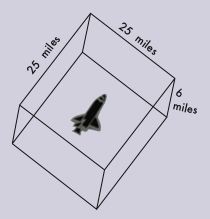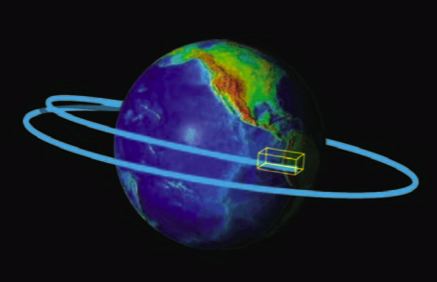ON-ORBIT COLLISION AVOIDANCE
ON-ORBIT COLLISION AVOIDANCE
−軌道上での衝突回避−
−軌道上での衝突回避−
The Space Control Center, operated by the 21st Space Wings 1st Space Control Squadron (a unit of Air Force Space Command), maintains an orbital data catalog on some 9,000 Earth-orbiting objects, from active satellites to space debris, some of which may be as small as four inches. The Space Control Center ensures that no known orbiting objects will transit an Orbiter "safety zone" measuring 6 miles deep by 25 miles wide and long (Figure A) during a Shuttle mission by projecting the Orbiters flight path for the next 72 hours (Figure B) and comparing it to the flight paths of all known orbiting or re-entering objects, which generally travel at 17,500 miles per hour. Whenever possible, the Orbiter moves tail-first while on orbit to minimize the chances of orbital debris or micrometeoroids impacting the cabin windscreen or the Orbiters wing leading edge.
第21スペースウィングス、第1宇宙管制部隊(アメリカ空軍スペースコマンドの1部隊)によって運用されているスペースコントロールセンターでは、地球の衛星軌道上を周回している9,000もの物体の軌道要素のカタログを維持管理していいます。このカタログには運用中の人工衛星からスペースデブリまでが含まれ、一部はサイズが4インチほどのものもあります。スペースコマンドは、シャトルのミッション中、オービターの周辺、縦横25マイル、奥行き6マイルの「セイフティゾーン」(図A)を軌道上の物体が通過しないように、シャトルの軌道を72時間先まで予測し(図B)、あらゆる軌道上ないし大気圏に再突入する物体と比較を行います。これらの物体は平均で時速17,500マイルで飛んでいます。軌道上でオービターが可能な限り尾部を進行方向に向けて飛ぶのは、軌道上の物体や微小天体が乗務員室の窓や主翼の前縁部に衝突する可能性を最小限に抑えるためです。
If an object is determined to be within 36-72 hours of colliding with the Orbiter, the Space Control Center notifies NASA, and the agency then determines a maneuver to avoid a collision. There were no close approach- es to Columbia detected during STS-107.
もし、36〜72時間以内にオービターと衝突する物体が発見された場合は、スペースコントロールセンターはNASAに通知し、衝突を回避するための機動が行われます。STS-107の間にはコロンビアに接近する物体は検知されていませんでした。

Figure A. Orbiter Safety Zone
図A: オービターセイフティゾーン

Figure B. Protecting the Orbiters flight path
図 B: オービターの飛行経路の保護